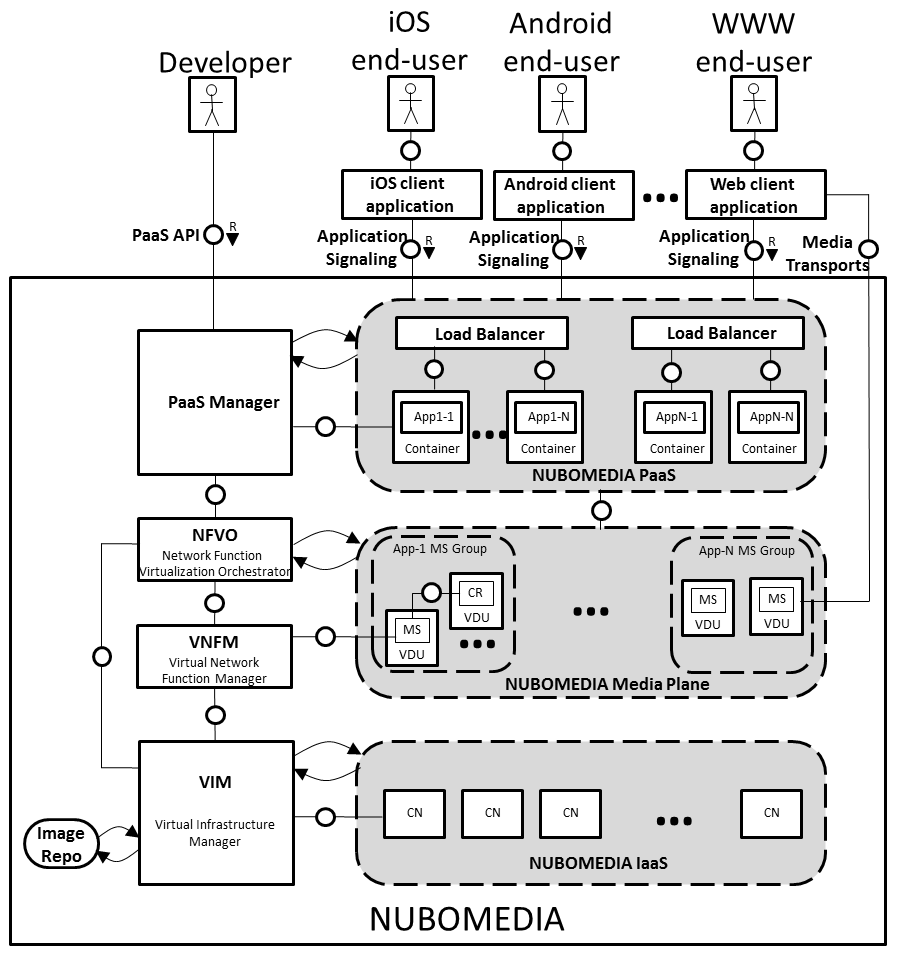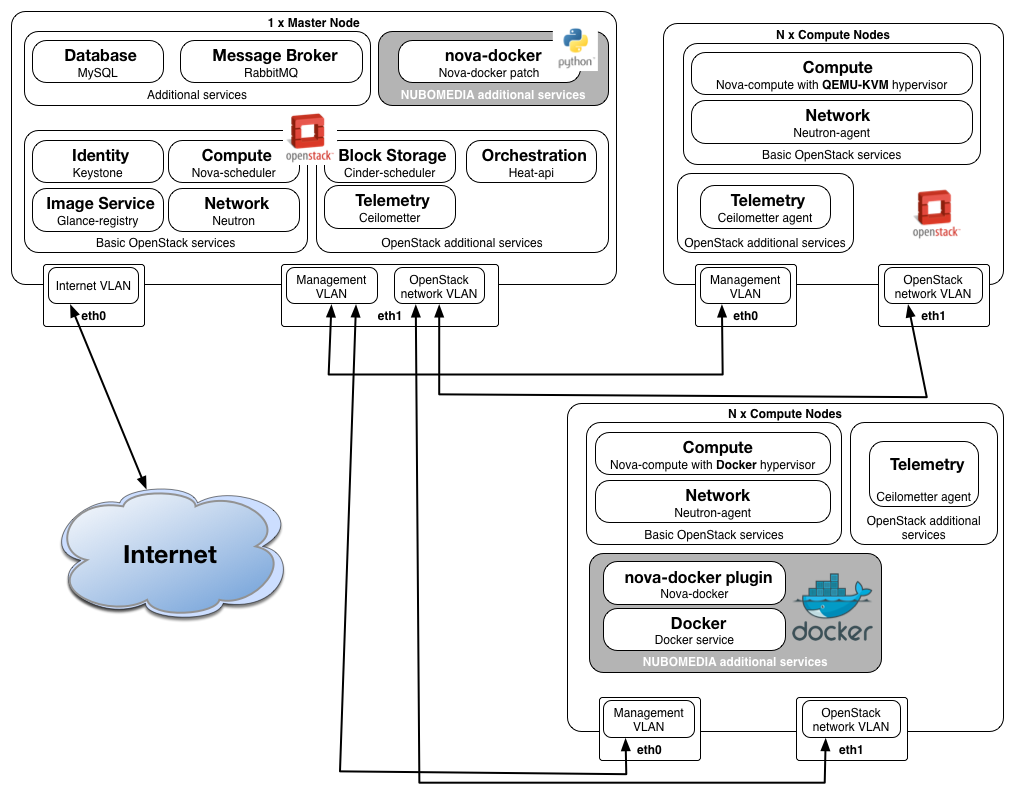NUBOMEDIA Architecture
The NUBOMEDIA architecture complies with the ETSI (European Telecommunications Standards Institute) NFV MANO (Network Function Virtualization Management and Orchestration) specification. The following picture shows this architecture created using Fundamental Modeling Concepts (FMC).

NUBOMEDIA Architecture
PaaS Manager
The PaaS Manager is the part of the system enabling developers to deploy and manage their server-side applications. The PaaS Manager is the component in charge of the full lifecycle of a NUBOMEDIA application, defined as a combination of the server-side application logic, hosted on the PaaS, and its required media functions, hosted on the NUBOMEDIA Media Plane, and NUBOMEDIA IaaS.
Take a look the PaaS Manager page for further details on this component, and also about the PaaS API and the PaaS GUI.
NUBOMEDIA PaaS
The NUBOMEDIA PaaS hosts the server-side application logic on top of on demand deployed Application Servers . For this, it needs to provide a set of services to the PaaS Manager, which mediates between developers and the PaaS. These services must make possible to deploy, scale and manage the application lifecycle. The NUBOMEDIA PaaS architecture comprise a number of building blocks, which are the following:
-
Core services: authentication, data store, scheduler, management/replication
-
APIs: The core services of the NUBOMEDIA PaaS are provided as micro-services. Micro-services is a software architecture approach in which complex applications are split into small independent processes which communicate among each other using language agnostic APIs.
-
Containers, pods and nodes: Containers are the basic unit of NUBOMEDIA PaaS applications. A container corresponds with the Linux notion of containers as a lightweight mechanism for isolating running processes. The NUBOMEDIA PaaS uses Docker containers. Nodes, in turn, are worker machines, physical or virtual, where pods are run. Following Kubernetes terminology, a pod is an application logical host in a containerized environment. In other words, pods are collocated groups of containers that make up the application.
-
Registry. The registry is a service for storing and retrieving Docker images. It contains a collection of Docker image repositories. In the case of NUBOMEDIA, all applications are deployed using Docker containers and the PaaS provides an internal registry for managing custom Docker images.
Network Function Virtualization Orchestrator (NFVO)
Each time a developer requests the instantiation of an application, the PaaS Manager firstly requests the deployment of a set of Virtualized Network Functions (VNF), defined as Network Service, then instantiates the application on the PaaS providing all the details of the media functions that are dedicated to it. NFV (Network Functions Virtualization) is designed to consolidate and deliver the networking components needed to support a fully virtualized infrastructure, including virtual servers, storage and even other networks.
The Network Function Virtualization Orchestrator (NFVO) is the component managing the lifecycle of a Network Service (NS) composed by multiple Media Server (MS) and a Cloud Repository (CR).
Virtual Network Function Manager (VNFM)
The Virtual Network Function Manager (VNFM) provides lifecycle management for a Virtualized Network Function (VNF). On the one hand, the MS-VNFM is specific and its functionalities are adapted to managing Media Server functions. On the other hand, the Cloud Repository one (CR-VNFM) is based on a generic architecture.
The MS-VNFM provides an API to applications deployed in the NUBOMEDIA PaaS for retrieving dynamically the available Media Servers. This API is consumed by the NUBOMEDIA Media API implementation to determine in which specific Media Server instance a newly created Media Pipeline is placed. Allocating new Media Pipelines is transparent to the developer, who just needs to create the Media Pipelines without worrying about where they are located. For this, the VNFM has been extended with the autoscaling component, providing semantics to that placement interface and guaranteeing the availability of Media Servers through an horizontal autoscaling mechanism based on two operations: scaling-out (i.e. to add resources when necessary) and scaling-in (i.e. to remove resources when they are no longer required). Both, the scaling-in and -out, are fired by simple autoscaling policies based on QoS metric thresholds, so that, for example, further resources are added when the average CPU load of Media Server instances is over an upper limit and resources are collected when it’s under a lower bound.
Virtual Infrastructure Manager (VIM)
The Virtual Infrastructure Manager (VIM) provides an interface for controlling the NUBOMEDIA IaaS. As in the ETSI NFV specification, the VIM follows the OpenStack approach and, through its APIs, offers the ability to start new computing resources by using already pre-configured images containing the appropriate artifacts for every of the required functions. The computing nodes are instantiated on the NUBOMEDIA IaaS on top of one or more Compute Nodes. Computing nodes are distributed across physical machines depending on the required flavors and resources.
NUBOMEDIA Media Plane
The NUBOMEDIA Media Plane provides the media capabilities to NUBOMEDIA applications. These capabilities include media transport, media archiving and media processing. The scalability of the NUBOMEDIA Media Plane is controlled by the NFVO component, which adapts it to the load offered by applications.
Media Server
A Media Server (MS) comprises a number of Media Pipelines (MPs). MPs are graphs of interconnected Media Elements (MEs). Each ME implements a specific media capability: media transport, media archiving or media processing.
A ME can be seen as a black box taking media from a sink, applying a specific media capability (e.g. processing, transporting, etc.), and issuing media through a source. MEs have different flavors (i.e. types) in correspondence with their different specialties (e.g. RtpEndpoint, RecorderEndpoint, FaceDetectorFilter, etc.).
Media Repository
The Cloud Repository provides scalable archiving capabilities to NUBOMEDIA. The Cloud Repository is able to store Repository Items, which comprise multimedia data and metadata. Repository Items can be recovered later querying them through ID or through any kind of information present into its metadata. Repository Item metadata consists on arbitrary JSON, which is quite convenient for developers.
NUBOMEDIA IaaS
NUBOMEDIA PaaS hides the underlying complexity of an IaaS platform that enables developers to build multimedia applications without infrastructure knowledge. The elastic nature of the IaaS enables developers to build multimedia apps that scale easily with an increase of usage. IaaS capabilities are exposed through APIs that are used by the Virtual Infrastructure Manager to provide hardware resources to the upper levels of the NUBOMEDIA IaaS.
The NUBOMEDIA IaaS is based on OpenStack and has two types of compute nodes. Some of the compute nodes are based on QEMU-KVM hypervisor and the other types of compute nodes are running Docker containers using the nova-docker plugin.
The main services of OpenStach which have been deployed for NUBOMEDIA are: Nova, Neutron, Glance, Cinder, Keystone and Horizon. All the services running on the IaaS level are available through certain end-points which are following OCCI-OGF standards.
For enabling of rapid deployment of new Media Server instances by the MS-VNFM, we created a nova-docker patch that pulls all docker container images available on Glance on all compute nodes running the Docker as a hypervisor. This way the instantiation of new Docker containers inside the IaaS is done in less than one second. The IaaS architecture is presented in the following diagram.
 IaaS Architecture
IaaS Architecture